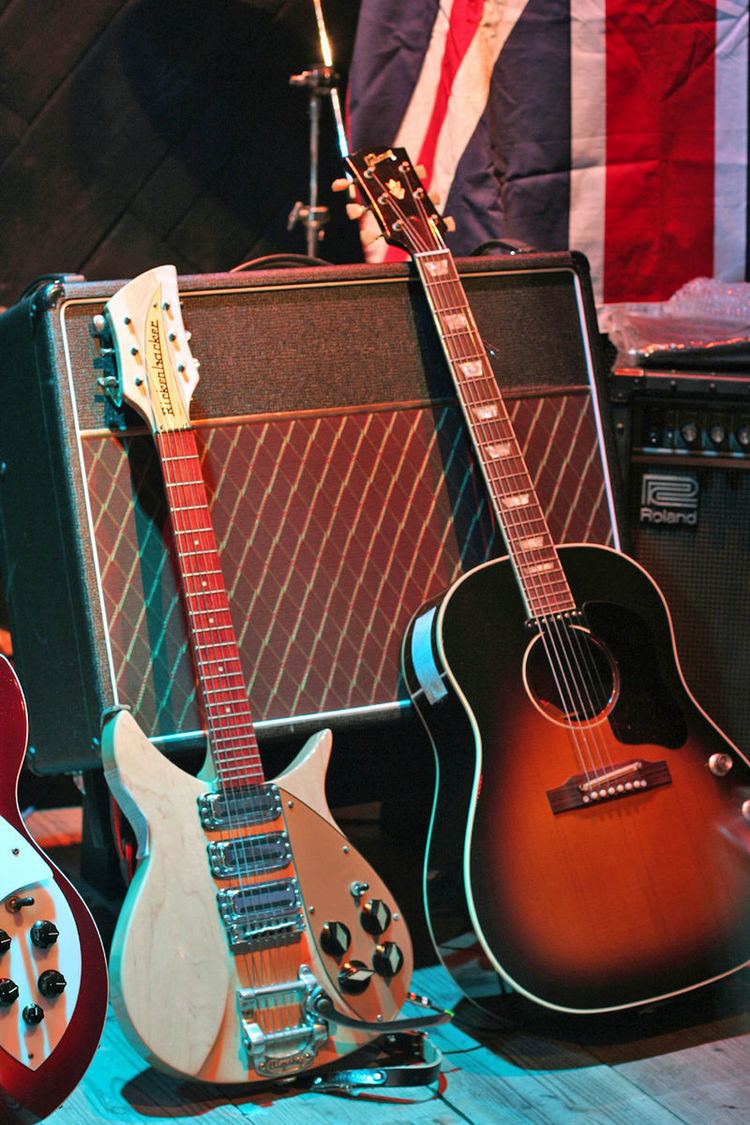John Lennon's musical instruments were both diverse and many, and his great fame resulted in his personal choices having a strong impact on cultural preferences.
John Lennon played various guitars with The Beatles and during his solo career, including the Rickenbacker (four variants thereof), Epiphone Casino, and various models of Gibson and Fender guitars.
His other instrument of choice was the piano, on which he also composed many songs. For instance, Lennon's jamming on a piano together with Paul McCartney led to creation of "I Want to Hold Your Hand" in 1963.
But Lennon's musicianship went far beyond guitar and piano. Julia Lennon was John's mother and her banjo was the first instrument that John Lennon learned to play before he switched to guitar: 'sitting there with endless patience until I managed to work out all the chords'. According to John, it was Julia who turned him onto rock 'n’ roll and actively encouraged him to pursue his musical ambitions. After Julia's untimely death in 1958 the instrument was never seen again and its whereabouts remains a mystery.
Lennon also played keyboards besides piano (electric piano, Hammond organ, harmonium, Mellotron, harpsichord, clavioline), harmonica, six-string bass guitar (either he or George Harrison, when McCartney was playing piano or guitar), and some percussion (in the studio).
Rickenbacker makes several "Lennon" model electric guitars, Gibson makes a limited-edition replica of his J-160E and an "inspired by" John Lennon Les Paul replicating the modified Junior. Epiphone also makes two "Lennon" edition guitars; the EJ-160e and the Inspired by John Lennon Casino
Lennon composed his biggest solo hit "Imagine" on a Steinway upright piano. In 2000, this piano was bought by George Michael at an auction for £1.45 million. Later, the piano was on charity tour.
Lennon used a variety of sound sources for his songs, such as radios, sound effect records, resonators, and even his own heartbeat. He recorded his, Ono's and their baby's heartbeat for sounds on the Wedding Album and Unfinished Music No. 2: Life with the Lions.
Rickenbacker 325 (four models):His original 1958 model, modified with Bigsby vibrato and nonstandard control knobs, nicknamed "Hamburg."A 1964 six-string model, serial number DB122, nicknamed "Miami."A twelve-string model (similar to DB122), with a trapeze tail piece. Only used a few times in the studio. John used it at home for songwriting purposes.A Rose, Morris model 1966, finished in Rickenbacker's Fireglo finish, and with a standard sound f hole. Used after John's second Rickenbacker had some damage. John used it for home studio use and it was given to Ringo sometime later on.Epiphone Casino (In 1968 Lennon had his sunburst Casino professionally stripped of its paint, removed the pickguard and changed the tuning machines to gold Grovers)A twelve-string Framus Hootenanny acoustic used during the Help! and Rubber Soul sessions and used on "Polythene Pam".Gibson Les Paul Jr. which was modified with the addition of a Charlie Christian pick-upGibson J-160E Acoustic-electric guitar1962 Fender Stratocaster finish in Sonic Blue used from 1965–68, was stolen in 1968.Fender TelecasterHöfner Senator: according to George Harrison it was bought in 1960 and used for his songwriting purposes. Later given to roadie Mal Evans.Guild Starfire XII: Given to him by Guild in August 1966, never saw studio usage. Most likely used for his home studio, somehow it got to Yoko Ono's first husband Tony Cox. Currently on display at the Hard Rock Cafe in Honolulu, Hawaii.Gretsch 6120: (used on the Revolver sessions), used for songwriting purposes at his home studio but has been in Lennon's cousin David Birch's hands since 1967. Currently on display at the Rock 'n' Roll Hall of Fame.A 1965 Martin D-28 (bought in early 1967 and taken to India in February 1968)An Ovation acousticA custom Yamaha acoustic given to him by wife Yoko OnoHöfner Club guitar, used after his Gallotone Champion suffered some damage.Gibson Les Paul 25/50 (given to Julian for Christmas in 1974)Fender Bass VIFender Jazz BassVox Guitorgan, John had received it for an advertisement but somehow the deal never came about and John eventually gave the guitar along with his Höfner Senator to road manager and friend Mal Evans.Sardonyx: a very rare semi-custom guitar built by Jeff Levin. Lennon played the Sardonyx on Double Fantasy and used it in session the day he was killed.Various Vox amplifiers, such as the AC-30 and the Super BeatleVarious Fender amplifiers, such as the Deluxe Reverb and the Twin ReverbMarshall amplifiersVox Tone BenderDallas Arbiter Fuzz Face pedal (during the "Let It Be" Sessions)Gibson Maestro Fuzz pedalVox Wah pedalSteinway upright piano model ZC. Bechstein Pianofortefabrik C. Bechstein D-280 concert grand pianoRhodes, Wurlitzer and Hohner Pianet pianosMellotron (the MK II model was used only at Lennon's home and is now residing at Interscope Records)Moog synthesizer used during Abbey Road.Vox Continental used at Shea Stadium and in the studio. Broke after Shea Stadium. Several other singular and dual manual Continentals were seen in the studio and at John's home from 1966–70.ClavinetHammond organHarmoniumHarpsichordClaviolineVarious Hohner diatonic, chromatic, chord and bass harmonicasTambourineMaracasCowbellCongasDrumsAKG K240 SextettBanjoWhistlingTape loopsSaxophone
